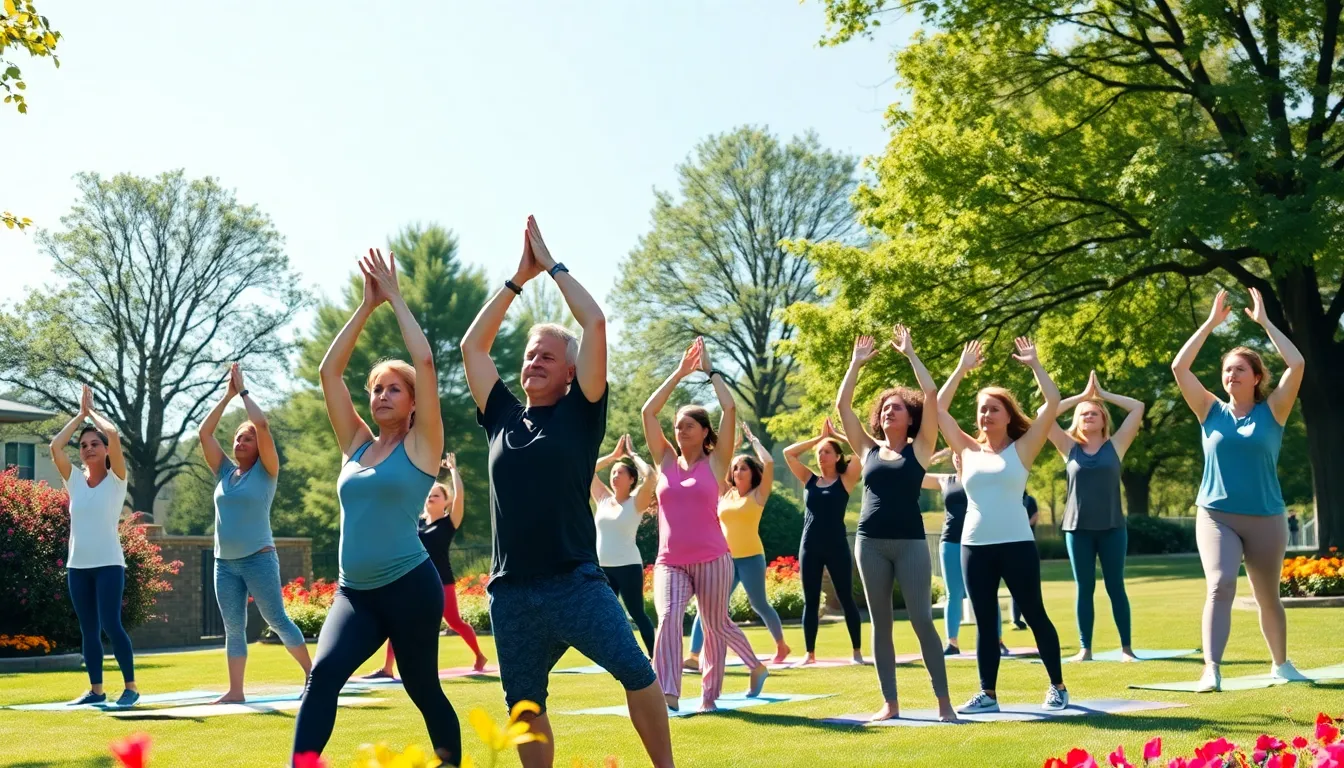As the sun rises and the fresh air beckons, outdoor workouts offer a refreshing alternative to the confines of a gym. Embracing nature while breaking a sweat not only boosts physical fitness but also enhances mental well-being. From running along scenic trails to practicing yoga in a serene park, the options are endless for those looking to invigorate their fitness routine.
Engaging in outdoor activities allows individuals to connect with their surroundings, making exercise feel less like a chore and more like an adventure. The benefits extend beyond just the workout; exposure to sunlight increases vitamin D levels, which can elevate mood and energy. Whether it’s a solo run or a group boot camp, outdoor workouts create a unique experience that can transform the way fitness enthusiasts approach their health journey.
Table of Contents
ToggleBenefits Of Outdoor Workouts
Outdoor workouts offer various advantages that enhance physical health and mental well-being. Engaging in exercise amid nature transforms the fitness journey into a holistic experience.
Physical Health Benefits
- Increased Cardiovascular Fitness: Outdoor activities like running and cycling improve heart health and endurance.
- Enhanced Muscle Strength: Terrain variation during workouts challenges muscles, promoting strength and stability.
- Higher Caloric Burn: Outdoor exercises often require more energy due to elements like wind resistance, increasing calorie expenditure.
- Improved Flexibility: Practices such as yoga or stretching outdoors encourage greater range of motion through dynamic environments.
- Natural Vitamin D Accumulation: Exposure to sunlight facilitates vitamin D synthesis, essential for bone health.
Mental Well-being Advantages
- Stress Reduction: Natural settings minimize stress levels, fostering relaxation and mental clarity.
- Mood Enhancement: Physical activity outdoors raises serotonin levels, positively impacting mood and emotional state.
- Boosted Motivation: Beautiful surroundings inspire consistency, making workouts feel enjoyable rather than a chore.
- Increased Mindfulness: Engaging with nature during workouts strengthens awareness, enhancing focus on movements and surroundings.
- Social Connectivity: Group outdoor workouts facilitate community building, promoting positive social interactions and support networks.
Types Of Outdoor Workouts

Outdoor workouts encompass a variety of activities that leverage natural environments. Each type offers unique benefits, catering to different fitness levels and goals.
Running and Jogging
Running and jogging enhance cardiovascular health and improve stamina. Both activities can be performed on roads, trails, or parks, allowing individuals to choose their preferred terrain. Benefits include increased endurance, weight loss, and mental clarity gained from fresh air. Regular engagement promotes leg strength and improves overall body composition.
Hiking and Trail Walking
Hiking and trail walking provide excellent opportunities for strength building and aerobic exercise. These activities engage various muscle groups, especially the legs and core, while navigating uneven terrains. Benefits include exposure to nature, enhanced mood, and improved flexibility. Hiking in different environments can increase calorie burn, maintain joint health, and strengthen cardiovascular systems.
Group Fitness Classes
Group fitness classes offer social interaction along with structured workouts. Available in parks or outdoor spaces, these classes might include activities like yoga, boot camps, or dance sessions. Benefits include increased motivation and accountability, as participants often encourage each other. Engaging in outdoor group classes can enhance camaraderie, promote team spirit, and improve overall physical fitness.
How To Get Started With Outdoor Workouts
Outdoor workouts require a few considerations for optimal enjoyment and safety. From selecting the perfect location to choosing appropriate attire, proper planning enhances the outdoor fitness experience.
Choosing The Right Location
Choosing the right location significantly impacts the outdoor workout experience. Consider these factors:
- Proximity: Select locations close to home or work to encourage consistency.
- Safety: Choose well-lit, populated areas for safety during workouts, especially in the early morning or evening.
- Terrain: Look for surfaces that match fitness goals. Grass, trails, or parks offer varied challenges for strength training or running.
- Accessibility: Ensure the location provides necessary amenities, such as restrooms, water fountains, or shaded areas for breaks.
- Scenery: Opt for visually appealing environments to enhance motivation. Beautiful landscapes can stimulate enthusiasm for outdoor exercises.
What To Wear For Comfort
Dressing appropriately for outdoor workouts ensures comfort and performance. Consider the following guidelines:
- Breathable Fabrics: Choose moisture-wicking materials to keep cool and dry during exercises.
- Layering: Wear layers for temperature fluctuations, allowing for easy adjustments as activity levels change.
- Footwear: Select suitable footwear based on the activity, like running shoes for jogging or trail shoes for hiking, ensuring adequate support.
- Sun Protection: Incorporate hats, sunglasses, and sunscreen to protect from UV rays during sunny workouts.
- Weather Considerations: Dress according to the weather forecast. Cold temperatures require insulation, while rainy conditions may necessitate waterproof attire.
By focusing on location and attire, outdoor workouts become comfortable, enjoyable, and more effective in achieving fitness goals.
Safety Tips For Outdoor Workouts
Engaging in outdoor workouts requires attention to safety for an optimal experience. These tips help ensure physical well-being during outdoor activities.
Staying Hydrated
Maintaining hydration during outdoor workouts is crucial. Drink water before, during, and after exercise. Carry a water bottle for easy access, especially during long sessions. Consider electrolyte-replenishing beverages for extended workouts in hot weather. Monitor body signals; symptoms of dehydration include dry mouth, dizziness, and fatigue. Adjust fluid intake based on temperature and exercise intensity.
Weather Considerations
Paying attention to weather conditions enhances outdoor workout safety. Check forecast details before heading out, as temperature and precipitation can affect comfort and performance. Dress appropriately for the conditions—light layers for warmth, moisture-wicking clothing for humidity, and windbreakers for windy days. Avoid strenuous activities during extreme weather, such as excessive heat or storms. Use sunscreen to protect skin during sunny days, reapplying every two hours or after sweating.
Embracing outdoor workouts can redefine one’s fitness journey. The blend of physical activity and connection to nature creates a unique experience that invigorates both body and mind. By choosing the outdoors, individuals unlock numerous benefits that go beyond traditional gym routines.
With the right planning and safety measures in place, outdoor workouts can be both enjoyable and effective. Whether it’s running through a park or participating in a group yoga class, the possibilities are endless. It’s time to step outside and discover the transformative power of exercising in nature.




